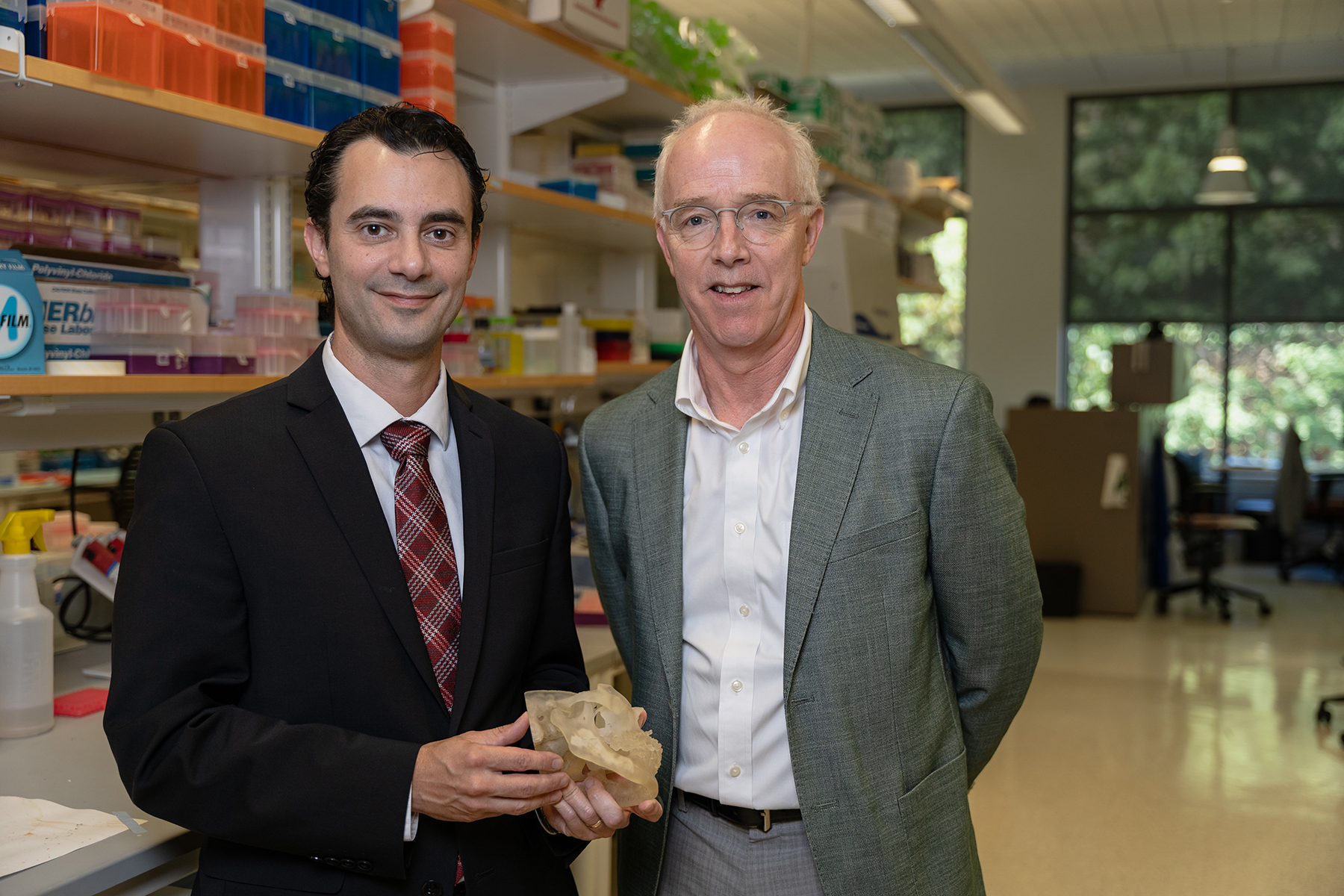Photography by Rayni Shiring/University of Pittsburgh

Alejandro Almarza, left, and Michael Gold, right
Two University of Pittsburgh researchers are leading a new $17 million study that is the largest collaborative funded by the National Institute of Dental and Craniofacial Research to study temporomandibular disorders (TMD). The project, called the Collaborative for REsearch to Advance TMD Evidence (CREATE), aims to collect data on TMD patients, to eventually be able to manage their pain more effectively. The CREATE Center will be part of TMD Collaborative for IMproving PAtient-Centered Translational Research (TMD IMPACT).
The data will be analyzed to perform in-depth phenotyping of patients, so that patients will be better able to receive appropriate treatments. These data will also be used to refine pre-clinical models to establish causal relationships and develop novel, more effective treatments.
Alejandro Almarza, professor of oral and craniofacial sciences, School of Dental Medicine, and the project’s director and contact principal investigator, said this will be the first study of this scope to collect such a wide array of data from these TMD chronic pain patients to help identify markers of pain. It will stratify a diverse cohort of 1,000 individuals with TMD and 300 pain-free controls across five national sites, collecting comprehensive data including brain imaging, bulk RNA sequencing, epigenomics, proteomics, microbiome analysis and more.
The five-year grant was approved in September 2025.
Michael Gold, professor of neurobiology, School of Medicine, and the project’s co-core principal investigator, compared the effort to the work on low back pain led by Gwendolyn Sowa, Physical Medicine and Rehabilitation Chair and professor, Department of Physical Medicine and Rehabilitation, and Nam Vo, professor of orthopaedic surgery, both in the School of Medicine at Pitt, as part of the Back Pain Consortium known as BACPAC. Both are working to gather data to inform a precision medicine approach for treatment of pain.
TMDs are an umbrella term for a heterogeneous set of more than 30 conditions that affect the temporomandibular joint in the jaw, Almarza explained.
“It's the first time that we’ll be able to recruit this many patients with TMDs and try to understand their pain condition,” he said.
This research will build on the findings of the largest previous research on TMDs, called Orofacial Pain: Prospective Evaluation and Risk Assessment, or OPPERA, which focused on trying to understand who would develop TMDs. The OPPERA studies, Gold said, “were fundamental for the field. This would be the next step and a much larger investment by NIDCR to study ongoing chronic pain in TMD patients.”
“We will be doing biospecimen collection and trying to identify markers of pain that will help us stratify the pain conditions.” Almarza explained that it takes a consortium to tackle a problem like TMDs, because of the patient volume needed for sufficient data. “It's relatively rare compared to, say, migraine, low back or knee pain. You're never going to get enough patients at any one site, so it requires a multisite comprehensive approach.”
Gold noted that pain is understood not only as a physical problem but through the biopsychosocial model, a framework that emphasizes the interaction of factors including genes, circadian rhythms, sleep patterns, responses to stress and a patient’s social situation.
“It really is an integrated, whole-person view of the problem, and that adds complexity, both in the factors influencing the manifestation of the pain syndrome, but also in its management,” he said.
“This study will enable us, in a very systematic way, to collect data across all those spheres and more accurately identify the subpopulations,” he said. “We can then better design clinical trials based on our ability to identify subpopulations. If we already know what their normal trajectory would be, it makes it far easier to determine if they might be responsive to X, Y or Z.”
Gold is enthusiastic about the grant’s educational component, which will draw together dental and medical students at Pitt. “We will have a hands-on training component for students that are interested in this line of investigation,” he said. “We're also developing curricula that will facilitate the transmission, if not implementation, of what is learned in this grant into dental clinics and into medical curriculum.”
The project’s other principal investigators are Yenisel Cruz-Almeida at the University of Florida; Richard Orhbach and Sonia Sharma at the University at Buffalo; and John Neubert at Texas A&M. Other partnering institutions are Missouri State, UT Health Houston, HealthPartners Institute and the TMJ Association, a patient advocacy organization.
“One of the things that is important here is the patient advocacy group,” Almarza said. “They are a key component to every decision we make.”
